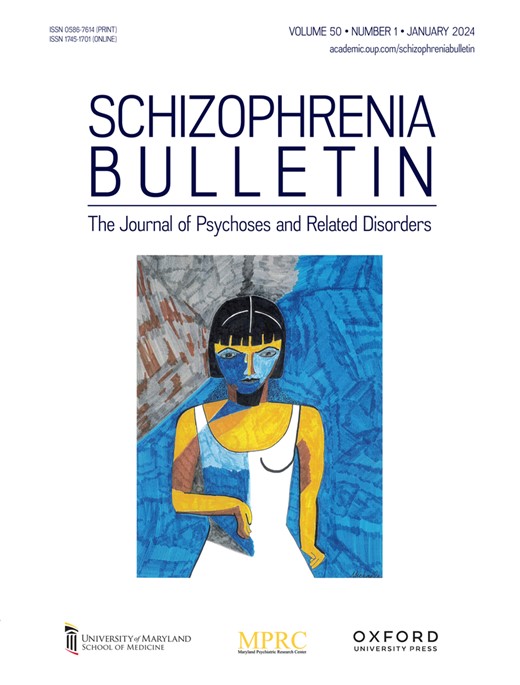未经治疗的慢性精神分裂症的神经结构、神经功能和临床特征:叙述性综述
IF 5.3
1区 医学
Q1 PSYCHIATRY
引用次数: 0
摘要
对慢性、未经治疗的精神分裂症(CUS)患者进行研究,可以为了解精神分裂症的自然病程以及抗精神病药物治疗如何影响病程和病情发展的神经生物学方面提供重要信息。我们系统回顾了 17 项关于 CUS 患者神经影像学、认知和流行病学方面的研究。这些研究于 2013 年至 2021 年间在上海市精神卫生中心、北京大学精神卫生研究所和华西磁共振研究中心进行。CUS与认知障碍、严重症状和特定的人口统计学特征有关,并且与抗精神病药物治疗患者的特征明显不同。此外,CUS患者的额叶和颞叶区域、胼胝体、皮层下和视觉处理区域,以及默认模式和躯体运动网络都存在神经结构和神经功能改变。随着病情的发展,会出现明显的结构性恶化,如额叶和颞叶皮质加速变薄、胼胝体基底各向异性分数进一步降低、丘脑灰质网络结节指标下降等,与认知障碍和临床预后的恶化相关。此外,纹状体也会肥大,这与抗精神病治疗无关。与短期抗精神病治疗对神经结构和神经功能的负面影响相反,长期治疗往往会带来显著的改善。它显著增强了白质的完整性以及杏仁核、海马和纹状体等关键皮层下区域的功能,从而有可能改善认知功能。这篇叙述性综述强调了 CUS 的渐进性神经生物学后遗症、早期发现和长期治疗精神分裂症的重要性,尤其是因为治疗可以减轻神经生物学恶化并改善临床预后。本文章由计算机程序翻译,如有差异,请以英文原文为准。
Neurostructural, Neurofunctional, and Clinical Features of Chronic, Untreated Schizophrenia: A Narrative Review
Studies of individuals with chronic, untreated schizophrenia (CUS) can provide important insights into the natural course of schizophrenia and how antipsychotic pharmacotherapy affects neurobiological aspects of illness course and progression. We systematically review 17 studies on the neuroimaging, cognitive, and epidemiological aspects of CUS individuals. These studies were conducted at the Shanghai Mental Health Center, Institute of Mental Health at Peking University, and Huaxi MR Research Center between 2013 and 2021. CUS is associated with cognitive impairment, severe symptoms, and specific demographic characteristics and is different significantly from those observed in antipsychotic-treated individuals. Furthermore, CUS individuals have neurostructural and neurofunctional alterations in frontal and temporal regions, corpus callosum, subcortical, and visual processing areas, as well as default-mode and somatomotor networks. As the disease progresses, significant structural deteriorations occur, such as accelerated cortical thinning in frontal and temporal lobes, greater reduction in fractional anisotropy in the genu of corpus callosum, and decline in nodal metrics of gray mater network in thalamus, correlating with worsening cognitive deficits and clinical outcomes. In addition, striatal hypertrophy also occurs, independent of antipsychotic treatment. Contrasting with the negative neurostructural and neurofunctional effects of short-term antipsychotic treatment, long-term therapy frequently results in significant improvements. It notably enhances white matter integrity and the functions of key subcortical regions such as the amygdala, hippocampus, and striatum, potentially improving cognitive functions. This narrative review highlights the progressive neurobiological sequelae of CUS, the importance of early detection, and long-term treatment of schizophrenia, particularly because treatment may attenuate neurobiological deterioration and improve clinical outcomes.
求助全文
通过发布文献求助,成功后即可免费获取论文全文。
去求助
来源期刊

Schizophrenia Bulletin
医学-精神病学
CiteScore
11.40
自引率
6.10%
发文量
163
审稿时长
4-8 weeks
期刊介绍:
Schizophrenia Bulletin seeks to review recent developments and empirically based hypotheses regarding the etiology and treatment of schizophrenia. We view the field as broad and deep, and will publish new knowledge ranging from the molecular basis to social and cultural factors. We will give new emphasis to translational reports which simultaneously highlight basic neurobiological mechanisms and clinical manifestations. Some of the Bulletin content is invited as special features or manuscripts organized as a theme by special guest editors. Most pages of the Bulletin are devoted to unsolicited manuscripts of high quality that report original data or where we can provide a special venue for a major study or workshop report. Supplement issues are sometimes provided for manuscripts reporting from a recent conference.
 求助内容:
求助内容: 应助结果提醒方式:
应助结果提醒方式:


